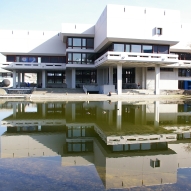Zusammenfassung
The structurally related peptides neuropeptide Y (NPY), peptide YY (PYY) and pancreatic polypeptide (PP) are endogenous agonists of the NPY receptor (YR) family, which in humans comprises four functionally expressed subtypes, designated Y1R, Y2R, Y4R and Y5R. Non-peptide antagonists with high affinity and selectivity have been described for the Y1R, Y2R and Y5R, but such compounds are still ...
Zusammenfassung
The structurally related peptides neuropeptide Y (NPY), peptide YY (PYY) and pancreatic polypeptide (PP) are endogenous agonists of the NPY receptor (YR) family, which in humans comprises four functionally expressed subtypes, designated Y1R, Y2R, Y4R and Y5R. Non-peptide antagonists with high affinity and selectivity have been described for the Y1R, Y2R and Y5R, but such compounds are still lacking for the Y4R. In this work, the structures of the high affinity selective (R)-argininamide-type Y1R antagonists BIBP3226 and BIBO3304 were linked via the guanidine or urea moieties to give homo-dimeric argininamides with linker lengths ranging from 31 to 41 atoms. Interestingly, the twin compounds proved to be by far less selective for the Y1R than the R-configured monovalent parent compounds. The decrease in selectivity ratio was most pronounced for Y1R versus Y4R subtype, resulting in comparable affinities of bivalent ligands for Y1R and Y4R (e.g. UR-MK177 ((R,R)-49): Ki = 230 nM (Y1R) and 290 nM (Y4R)). With a Ki value of 130 nM and a Kb value of 20 nM, UR-MK188 ((R,R)-51) was superior to all Y4R antagonists known to date. The S,S-configured optical antipodes of UR-MK177 and UR-MK188 (UR-MEK381 ((S,S)-49) and UR-MEK388 ((S,S)-51)) were synthesized to investigate the stereochemical discrimination by the different receptor subtypes. Whereas preference for R,R-configured argininamides was characteristic of the Y1R, stereochemical discrimination by the Y4R was not observed. This may pave the way to selective Y4R antagonists.




 Altmetric
Altmetric